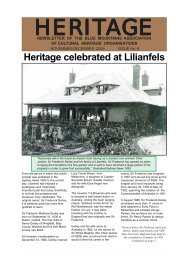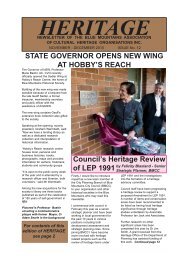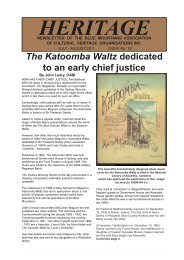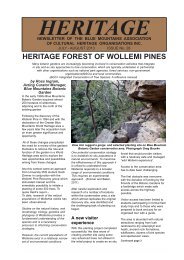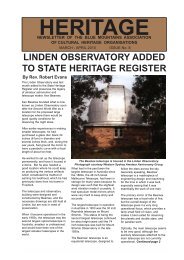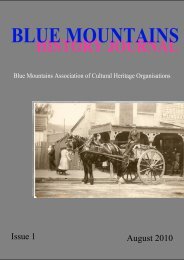Newsletter No. 15 - Blue Mountains Association of Cultural Heritage ...
Newsletter No. 15 - Blue Mountains Association of Cultural Heritage ...
Newsletter No. 15 - Blue Mountains Association of Cultural Heritage ...
Create successful ePaper yourself
Turn your PDF publications into a flip-book with our unique Google optimized e-Paper software.
Factory women were ordinary women in<br />
extraordinary circumstances<br />
Continued from page 9<br />
The actual pr<strong>of</strong>iles <strong>of</strong> the women<br />
transported don’t match the<br />
common stereotype at the time, <strong>of</strong><br />
morally degenerate, prostitutes,<br />
from a crime class, unskilled and<br />
illiterate.<br />
The majority were not <strong>of</strong> a crime<br />
class. For over 90% <strong>of</strong> the women<br />
transportation was a result <strong>of</strong> first or<br />
second <strong>of</strong>fences. They were mainly<br />
transported for theft.<br />
The women brought over 180<br />
trades with them, demonstrating<br />
their skills and industry.<br />
Just over half <strong>of</strong> the English were<br />
literate and just under half <strong>of</strong> the<br />
Irish.<br />
These facts present quite a different<br />
picture to the descriptions <strong>of</strong><br />
degenerate women with little<br />
chance <strong>of</strong> reform.<br />
The factories were called factories<br />
because each was a site <strong>of</strong><br />
production. The women produced<br />
spun wool and flax in all the<br />
factories.<br />
There were 13 female factories -<br />
Parramatta (2), Bathurst,<br />
Newcastle, Port Macquarie (2),<br />
Moreton Bay (2), Hobart Town,<br />
Georgetown, Cascades,<br />
Launceston and Ross.<br />
The experience in the factories<br />
varied according to when the<br />
women were in the factory and<br />
which factory they were in.<br />
The earliest factory still in existence<br />
is the Greenway designed<br />
Parramatta Female Factory.<br />
This was a Governor Macquarie<br />
initiative and the second factory in<br />
the country. Over half <strong>of</strong> the factory<br />
women experienced the Parramatta<br />
Female Factories.<br />
The factory women were ordinary<br />
women in extraordinary<br />
circumstances.<br />
They became the business women,<br />
farmers, mothers, teachers and<br />
workers that formed Australia.<br />
Why are the factory women<br />
significant to us now? The<br />
significance today is somewhere in<br />
the spaces between myth and<br />
reality.<br />
The Australian perceptions <strong>of</strong><br />
strength in adversity we can survive<br />
anything, do anything, mateship,<br />
lack <strong>of</strong> deference to authority and<br />
the sense <strong>of</strong> humour can be tracked<br />
to these convict women and their<br />
partners.<br />
Also these women’s stories provide<br />
the paper on which we can<br />
mythologise, construct stories <strong>of</strong><br />
ourselves and our lives.<br />
We can rewrite our desires to act<br />
with strength against adversity and<br />
‘survive’ with a sense <strong>of</strong><br />
empowerment. In many ways we<br />
are the stories we tell.<br />
The factory women by living their<br />
lives through opportunity in the<br />
colony were part <strong>of</strong> a quiet<br />
revolution where they taught their<br />
children and their children’s children<br />
about their rights and equity which<br />
we treasure now.<br />
Despite little tangible evidence,<br />
outside government records, the<br />
experiences and nature <strong>of</strong> these<br />
women has been significant in<br />
forming who we are as Australians.<br />
As Kate Grenville describes in Joan<br />
makes History: There was not a<br />
single joy I could feel that countless<br />
Joans had not already felt, not a<br />
single mistake I could make that<br />
had not been made by some Joan<br />
before me... and although you may<br />
not think so to look at me, I am the<br />
entire history <strong>of</strong> the globe walking<br />
down the street…and like them all I,<br />
Joan, have made history 5 .<br />
(Endnotes)<br />
1 Howard, John The State <strong>of</strong> the<br />
Prisons in England and Wales,<br />
William Eyres, Washington 1777,<br />
p.173<br />
2 Howard, John The State <strong>of</strong> the<br />
Prisons in England and Wales,<br />
William Eyres, Washington 1777,<br />
p.289<br />
3 Hunter to Portland, 3 July<br />
Historical Records <strong>of</strong> Australia,<br />
Series 1, Volume 4. p.586<br />
4 Marsden, Samuel Letter from Rev.<br />
Samuel Marsden to Governor<br />
Macquarie 19 th July 18<strong>15</strong><br />
5 Grenville, Kate Joan Makes<br />
History University <strong>of</strong> Queensland<br />
Press, St Lucia1998, pp.278-279<br />
About the author - Gay Hendriksen<br />
Gay Hendriksen is a <strong>Blue</strong><br />
<strong>Mountains</strong> resident and has<br />
worked in the gallery and museum<br />
environment for 21 years including<br />
local history museums in<br />
Shellharbour and Sydney, Penrith<br />
Regional Gallery, <strong>No</strong>rman Lindsay<br />
Gallery and Museum and now<br />
Parramatta <strong>Heritage</strong> Centre.<br />
She also curated the exhibition<br />
Women Transported - Life in<br />
Australia’s Convict Female<br />
Factories which has won national<br />
and state awards in excellence<br />
and is currently touring 5 states.<br />
She is also currently president <strong>of</strong><br />
the Parramatta Female Factory<br />
Action Group which has the aim <strong>of</strong><br />
saving the Greenway designed<br />
Parramatta Female Factory which<br />
was commissioned by Governor<br />
Macquarie and making it<br />
available for all to experience.<br />
Last month she presented a paper<br />
at the <strong>Blue</strong> <strong>Mountains</strong> Family<br />
History Seminar.<br />
Readers are invited to view the<br />
Parramatta Female Factory Action<br />
Group’s website and take a tour<br />
with experts on the history and<br />
significance <strong>of</strong> this part <strong>of</strong> our<br />
Australian <strong>Heritage</strong>.<br />
www.petitionbuzz.com/petitions/<br />
savethefemale factory/o/2<br />
HERITAGE 10<br />
May - June 2011




